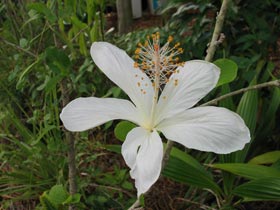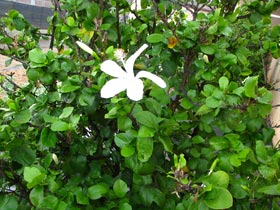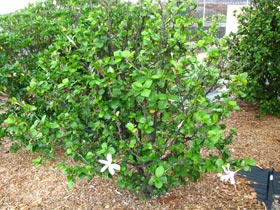Hibiscus arnottianus subsp. immaculatus
Genus
Hibiscus
Species
arnottianus
Subspecies
- immaculatus
Hawaiian Names with Diacritics
- Aloalo
- Hau hele
- Kokiʻo kea
- Kokiʻo keʻokeʻo
- Pāmakani
Hawaiian Names
- Aloalo
- Hau hele
- Kokio kea
- Kokio keokeo
- Pamakani
Common Names
- Molokaʻi white hibiscus
Synonyms
- Hibiscus immaculatus
Distribution Status
Endemic
Endangered Species Status
Federally Listed
Plant Form / Growth Habit
- Shrub
- Tree
Mature Size, Height (in feet)
- Shrub, Tall, Greater than 10
- Tree, Small, 15 to 30
Life Span
Long lived (Greater than 5 years)
Landscape Uses
- Hedges
- Screening
- Specimen Plant
Additional Landscape Use Information
The subspecies immaculatus is an easy to care for and very rewarding beautiful native hibiscus in the landscape which does not seem to grow as large as the other two subspecies.
Source of Fragrance
- Flowers
Additional Fragrance Information
Kokiʻo keʻokeʻo flowers are often weakly fragrant.
Plant Produces Flowers
Yes
Flower Type
Showy
Flower Colors
- White
Additional Flower Color Information
The pure white flowers also have a white center or staminal column and long narrow petals.
Blooming Period
- Year Round
Plant texture
- Fine
- Medium
- Coarse
Additional Plant Texture Information
Leaves are from 1 1/2 to no greater than 11 inches long.
Leaf Colors
- Medium Green
Additional Pest & Disease Information
Plants are prone to sucking insects. Chinese rose beetles can be removed by hand. Leaf spot is also a common fungal disease.
Fertilizer
Fertilize kokiʻo keʻokeʻo using a 2-1-3 or 2-.5-3 ratio with minor elements. It is important to keep the phosphorus low because it tends to accumulate and prevents the nitrogen and potassium from working. Minor elements such as magnesium and iron are also important to maintain healthy green foliage. [1]
Pruning Information
Prune to maintain shape, but avoid heavy pruning.
Water Requirements
- Dry
Additional Water Information
When plant is well established water twice monthly or more during dry months.
Soil must be well drained
Yes
Light Conditions
- Full sun
- Partial sun
Additional Lighting Information
Kokiʻo keʻokeʻo prefers full sun to flower best.
Tolerances
- Drought
- Wind
Soils
- Cinder
- Organic
Natural Zones (Elevation in feet, Rainfall in inches)
- Less than 150, 50 to 100 (Mesic)
- 150 to 1000, 50 to 100 (Mesic)
- 1000 to 1999, 50 to 100 (Mesic)
Additional Habitat Information
This subspecies of kokiʻo keʻokeʻo is extremely rare in its native habitat on Molokaʻi where the few remaining plants grow in wet to mesic forests (50-1600 ft.). [3]
![]() Special Features and Information
Special Features and Information
General Information
The large Mallow family Malvaceae contains some 2,300 species, with notables such as okra, cacao, durian, baobab, kenaf, and cotton. [4]
There are perhaps as many as 300 species worldwide in the genus Hibiscus. There are six native species of hibiscuses in Hawaiʻi and all but one are endemic.
Kokiʻo keʻokeʻo (Hibiscus arnottianus) has three uniquely different subspecies. The Molokaʻi subspecies immaculatus is an endangered species and extremely rare in its native habitat.
Etymology
The generic name Hibiscus is derived from hibiscos, the Greek name for mallow.
The specific and subspecific epithets are named in behalf of George Walker Arnott (1799-1868), Scottish botanist, traveler, collector and director of the Glasgow Botanic Gardens. [5]
Flowers have a white staminal (stamen) column and fittingly has the botanical subspecies name immaculatus is Latin for "without spots" or "pure."
Hawaiian Names:
Aloalo is the name given for hibiscus in general.
Hau is an introduced hibiscus (Hibiscus tiliaceus), perhaps by early Hawaiians. Hau hele literally means "traveling hau."
Kokiʻo kea and Kokiʻo keʻokeʻo literally mean "white kokiʻo" and "white, white [clear white] kokiʻo," respectively.
Pāmakani is a name given to this species of hibiscus and also to a native violet (Viola chamissoniana).
Background Information
The two native Hawaiian white hibiscuses, Hibiscus arnottianus and H. waimeae, are the only species of hibiscuses in the world known to have fragrant flowers! Also, See the subheading "Additional Fragrance Information" under "Plant Characteristics" for more information.
New DNA evidence suggests that Hibiscus arnottianus subsp. immaculatus may now be given full species status as Hibiscus immaculatus. [7]
Early Hawaiian Use
Both the native red and white hibiscuses were grown near their houses for their flowers. [6]
Modern Use
Two cultivars are recognized for this subspecies: cv. 'Molokaʻi White' and cv. 'Nuʻuanu White'. [2]
Additional References
[1] Jill Coryell, Hibiscus Lady http://www.hibiscusladyhawaii.com/
[2] http://www2.bishopmuseum.org/HBS/botany/cultivatedplants/?str=hibiscus [Accesed 10/1/08]
[3] "Recovery Plan for Molokai Plant Cluster," page 44.
[4] http://en.wikipedia.org/wiki/Malvaceae [Accessed 10/14/09]
[5] "Hibiscus: Hardy and Tropical Plants for the Garden" by Barbara Perry Lawton, page 105.
[6] "Native Planters in Old Hawaii--Their Life, Lore, & Environment" by E. S. Handy and Elizabeth Green Handy, page 233.
[7] "Hawaii Landscape" Sept./Oct. 2013 issue, pages 16-17.
PHOTOS FOR THIS SPECIES CAN BE SEEN AT THE LINK (Copy & Paste to your browser):
https://www.flickr.com/search/?user_id=50823119%40N08&sort=date-taken-desc&view_all=1&text=Hibiscus%20arnottianus%20subsp.%20immaculatus
Plant Gallery
Back to Plant List
Other Nursery Profiles for Hibiscus arnottianus subsp. immaculatus



